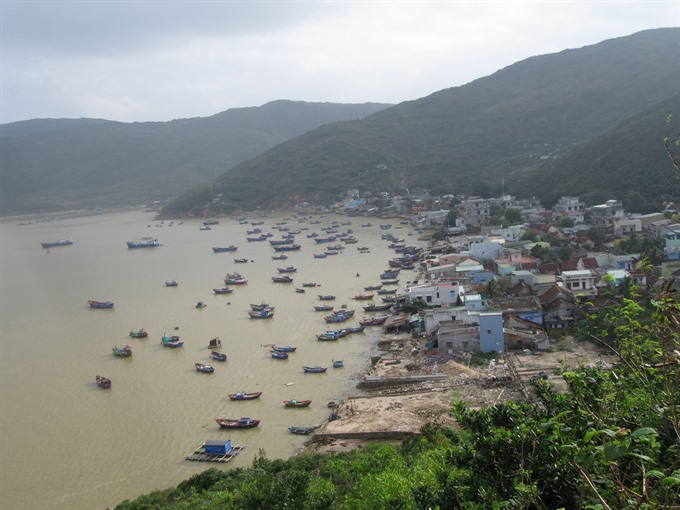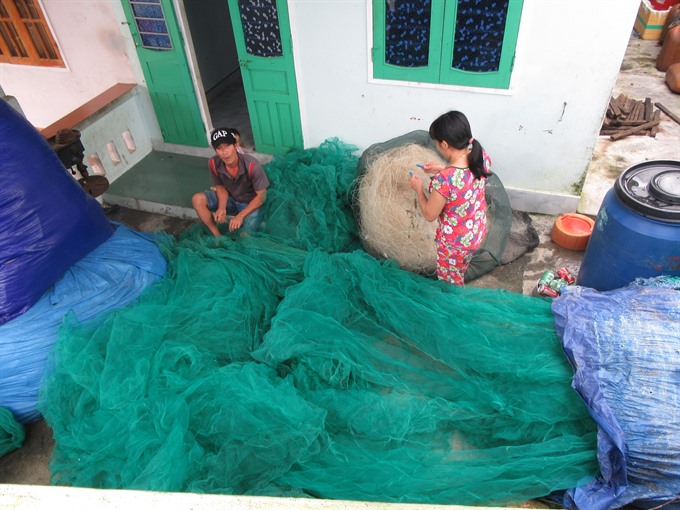 Life & Style
Life & Style

A trip to Hải Minh fishing village in Quy Nhon city will offer you peaceful moments
 |
| Gaze-worthy: Panoramic view of the Hải Minh fishing village. — VNS Photo Bạch Liên |
By Bạch Liên
In a routine unchanged for decades if not centuries, a working day is well under way in a fishing village as the sun rises over the Quy Nhơn Beach in Bình Định Province.
The fishermen of Hải Minh Village are at sea spreading their nets to catch fish and other creatures. In a corner of the village, elderly women carry stuff to sell in the market. Children prepare to go to school.
The peaceful life in the village is a far cry from the bustle of central Quy Nhơn City, although it takes just 10 minutes of travelling by sea to get there.
Settled on the Phương Mai peninsula, Hải Minh is still unknown to many people who visit Quy Nhơn, but it is an ideal destination for those who enjoy the simplicity and beauty of rural life.
A boat from the Hàm Tử Wharf in Quy Nhơn City will take about 10 minutes to reach the Hải Minh fishing village. Their little houses are so close to the sea that you can walk directly into one of them from the boat.
The small alleys in the village are lined by lush greenery and lots of fishing nets, coracles, and fishing boats.
As they see us in the distance, the villagers wave and smile at us. Striking up a conversation with them is very easy. They are eager to talk.
“Just a few days ago, we met another group of tourists coming here from Hà Nội. Just imagine, they even came here by airplane, paying VNĐ1.5 million (US$66) just for the ticket!” exclaimed Nguyễn Văn Hồng, excited about these facts, as he sat on a chair in front of his house, breathing in fresh air from the sea.
An air trip is too luxurious for someone who earns a living catching and selling fish in the local market.
His hard, frugal life has not robbed him of the innocence and sincerity that are writ large in the smiles that light up his face.
“I met them by chance on my way back home after I’d caught a lot of fish. They were happy to see my catch. They wanted me to cook some for them, and I did. We had a lot of fun,” he said, laughing.
Hồng doesn’t go to the city very often. Like other villagers, he finds everything he and his family needs in the village itself: market, pagoda, and schools.
But children can only attend primary school in the village. For any “higher education” – secondary school and high school, they would take the boat everyday to the city and back.
 |
| Net worth: A family repairs fishing nets in Hải Minh Village. — VNS Photo Bạch Liên |
Apart from the sincere and welcoming residents, another big attraction of Hải Minh is its beautiful scenery that every nature lover will thoroughly enjoy.
After walking on a sinuous pathway on a mountainside for about 20 minutes, we reached an oversized statue of 13th century national hero Trần Hưng Đạo, which can be seen in the distance from the city centre.
This 17m high statue has been erected on a promontory, 40m above sea level, which overlooks the village.
The statue, built in 1972, has been recognised as a historical heritage. It honours the exploits of Trần Hưng Đạo, who successfully defeated Mongol invaders in Việt Nam. He is frequently mentioned as one of the top ten generals in the world’s military history.
Standing at the foot of the imposing statue, we enjoyed the magnificient, panoramic view of the coast, along with the Thị Nại Bridge, the longest sea-crossing bridge in the country, a source of pride for local residents.
Watching the sea dotted with ships close to Hải Minh Village, listening to the melodious songs of wind, sea waves, and seagulls landing and flying in apparent abandon, one can easily lose track of time.
Behind the statue, a pathway leads to a beach hidden at the foot of a mountain. The Rạn Beach is still unspoilt now, and we can only hope it remains that way.
The Phước Mai Lighthouse, built by the French 100 years ago, and the Hang Dơi Cave that hosted thousands of bats before 1975 are places worth visiting in the village.
Whenever you visit Quy Nhơn, do not hesitate to spend a few hours to visit Hải Minh Village. Experience the friendliness and warmth with which the locals welcome you, and admire Quy Nhơn City from another angle.
The best time to visit is from February to August. No risks of storms, just sunshine. — VNS